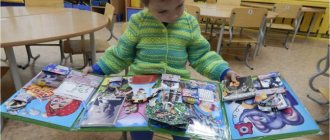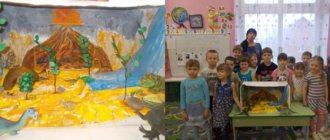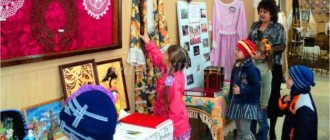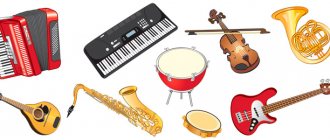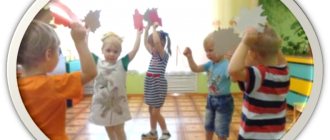Progress of the game.
Using a rhyme, a child is selected to play the role of king. The remaining child workers are divided into several groups (3 - 4)
and agree on what they will do and what work they will be hired for.
Then they approach the king in groups .
Workers. Hello King!
King. Hello!
Workers. Do you need workers?
King. What can you do?
Workers. Guess it!
Children, acting with imaginary objects, demonstrate various professions: cooking, washing clothes, sewing clothes, embroidering, watering plants, etc. The king must guess the profession of the workers. If he does it correctly, he will catch up with the fleeing children. The first child caught becomes king. Over time, the game can be complicated by introducing new characters (queen, minister, princess, etc.), as well as inventing the characters of the characters (king - greedy, cheerful, evil; queen - kind, grumpy, frivolous).
Card No. 12 “BIRTHDAY”
Target. Develop skills in working with imaginary objects,
cultivate goodwill and contact in relationships with peers.
ORGANIZATION OF THEATER ACTIVITIES WITH CHILDREN IN THE THIRD YEAR OF LIFE
Kovaleva Natalya Nikolaevna Podkopaeva Irina Ivanovna educators Tuma Irina Aleksandrovna teacher of additional education MBDOU DS No. 62 “Golden Beehive” Starooskolsky urban district
ORGANIZATION OF THEATER ACTIVITIES WITH CHILDREN IN THE THIRD YEAR OF LIFE
The federal state educational standard for preschool education is aimed at solving various problems, one of which is the development of the child’s abilities and creative potential . It is in preschool age that the foundations development and creative abilities .
Theatrical activities in kindergarten are a good opportunity to reveal the creative potential of the child and nurture the creative orientation of the individual.
Since creative personality traits begin to appear at an early age, we believe that it is very important not to miss this period and begin introducing children to theatrical activities in the first junior group.
We carry out work on the formation of a creative personality through the development of theatrical activities in the first junior group in several stages.
Advertising message
The first stage takes place during the period of children’s adaptation to the conditions of kindergarten. We use the technique of greeting children in the morning with the Parsley doll, which helps to establish friendly relations between teachers and children. The use of dolls and “doll conversations” helps relieve mental stress and shift the child’s attention from his own experiences to a new object – a doll. A folk toy “tells” nursery rhymes, folk songs, and fairy tales to children, and develops children’s desire to make contact, play with peers, and share toys.
To form initial ideas about the theater, we organize viewings of performances prepared by pupils of senior preschool groups. We begin introducing children to theater with the simplest form that is accessible to a child’s emotional response – puppet theater. In order for the kids to be able to grasp the meaning of the events taking place on stage, shortly before the start of the performance we tell them about the content of the performance. During the performance itself, we connect the children’s attention to the events taking place on stage. During these spectacles, children learn to watch and understand what is happening, express their emotions, and react to the positive and negative actions of the characters.
We constantly use the technique of theatricalization in the form of game educational situations in direct educational activities. Theatrical characters interact with children and perform various actions, which increases cognitive activity and promotes the development of creative skills.
We assign a large role to individual work, taking into account that children have different levels of development and poorly developed joint activity skills. Since it is easier for a child to show than to tell, we base our work on the use of imitative, imitative movements. At the same time, we use various forms of work. So, when waking up children after a nap, we suggest “depicting” how the ducklings wake up, stretch, flapping their wings, etc. We do morning exercises by playing out scenes from familiar fairy tales. Characters from the bi-ba-bo theater and glove puppets participate in the outdoor games.
Having analyzed the results of activities with children at the first stage, concluding that the work carried out contributed to the favorable adaptation of children to kindergarten and the maintenance of the emotional state of children, we move on to the next stage of work.
When children are accustomed to joint activities and communication, we use elements of role-playing theatrical play. In it, we follow the principles of gender education: girls in the play corner, first with the help of teachers, and then independently organize games in which, imitating adults, they talk to dolls, put them to bed, feed them, and wash them. Boys ride dolls in cars, build houses for them, and do shopping.
The theatrical games we use include elements of dramatization, which are based on the corresponding actions of the role player. When playing together with adults, children reproduce actions characteristic of the character and show good feelings towards toys. We develop in children the ability to display everyday actions in a role-playing theatrical game based on the children’s ideas about family relationships.
In order to educate children such qualities as sincerity, kindness, responsiveness and others, we use games - dramatizations based on familiar fairy tales.
We conduct simulation games in which we invite children to imitate the actions of people, animals and birds. In games that imitate the images of well-known fairy-tale characters, children depict how animals from the fairy tales “Teremok”, “Kolobok” move and speak, like “Birds are flying”, “The Bunny is jumping”, “The Bear is coming to visit”. Thanks to this, children develop imagination and freedom of imagination.
Once a month, we conduct direct educational activities on artistic and aesthetic development (acquaintance with fiction) entirely as a theatrical activity. A work of art presented to children of primary preschool age in the form of a theatrical production is absorbed and remembered much better. We offer children performances with a simple, clear and funny plot, familiar characters and a happy ending.
In the process of conducting didactic games “Find a pair”, “Guess who lives in which fairy tale”, “Who is hiding?” we use three-dimensional characters from tabletop, finger and other theaters.
Noting the positive dynamics in the development of theatrical activities, we came to the conclusion that children have accumulated experience in displaying the surrounding reality in the game. They began to show emotional responsiveness, engage in concrete actions of help, care, and participation.
Based on these findings, we move on to stage 3.
To develop skills in theatrical activities, we use role-playing reading of simple poems and nursery rhymes, accompanied by a demonstration of finger or table theater. We select folklore works that are figurative, understandable to children, and always contain dialogue: “Kitsonka-Murysonka”, “Vanka-Vstanka”.
Then, together with the children, we stage individual scenes and short, simple works. To master these skills, in individual work we provide children with the opportunity to play contrasting roles - an old bear and a little bear cub, an angry dog and a defenseless puppy. By playing out a number of poems and nursery rhymes with children, we encourage them to combine words and movements. Taking into account the age characteristics of children, the fact that children “think with their hands”: they do not so much think as act directly, we give the kids the opportunity to play with the theater figures themselves.
Next we move on to the theatricalization of a specific work. To do this, we plan and carry out a whole range of events: for example, to stage the fairy tale “Kolobok”, we invite children during morning exercises to convey in motion how the Teddy Bear, the Hare, and the Fox walk through the forest. In the process of organized activities for the development of speech, we train children in the dialogue between an old man and an old woman, Kolobok and Bunny. In the course of organized activities for artistic and aesthetic development (musical activity), we train children in singing the Kolobok song, learn the Bunny dance, etc.
Theatrical activities began to occupy an important place in the pedagogical process of the first junior group, contributing to the comprehensive creative development of children.
*******
This material was presented at the regional scientific and practical conference “FORMATION OF THE CREATIVE PERSONALITY OF A PRESCHOOL CHILD THROUGH THEATERIC ACTIVITIES”
Progress of the game:
Teacher in front of the children sitting at the table. There is a house on the table with a little bear looking out of the window.
Teacher. Oh, whose face appeared in the window?
The children answer that it is a bear. The teacher takes him out from behind the house and draws the children’s attention to how the bear purrs when greeting them. Then he asks the children to purr in the same way.
Suddenly the bear hides behind the house.
Teacher: Teddy bear, playful Teddy bear!
Where are you? Where are you? Answer me!
Teddy bear, Naughty Teddy Bear!
Where are you? Where are you? Show yourself!
The bear's head appears in the window again. He shakes his head and purrs. Children imitate him. The display game is repeated at the request of the children. Various characters familiar to children can hide. And every time the teacher encourages the children to imitate the “voices”
these characters.
Card No. 6 “We won’t tell you where we were, but we’ll show you what we did.”
Goal: to encourage children’s attempts to participate in a collective conversation and make joint decisions; develop creative imagination; encourage children to improvise.
